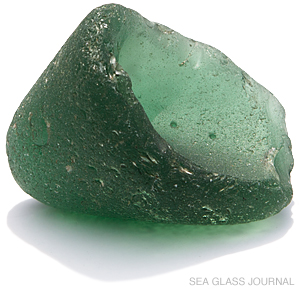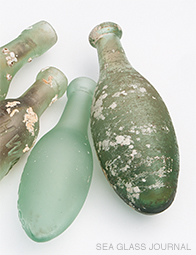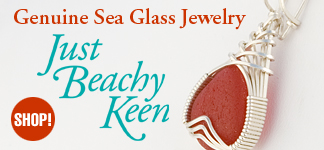The Sea Glass Shard of the Month: August 2014
Torpedo Bottle Bottom

See MORE IMAGES
Sea Glass Specifications:
Color: Forrest Green
Max Diameter: 57.2 mm (2.25")
Weight: 123.1 grams (4.34 oz)
Estimated Age: 130 to 150 Years Old
This month we are going to look at a forrest green sea glass specimen originating from an unusual type of bottle bottom that collectors commonly refer to as a "round bottom." While most bottles have bases that were designed to have the bottle standing upright, round bottom bases were made with the intent that the bottles had to be stored on their sides.

The torpedo bottle has an ovoid shaped body with a pointier bottom compared to the cylinder bottles below.

Cylinder bottles have straight sides with a completely rounded bottom.
Facts of Interest
While William F. Hamilton was credited with the UK patent in 1809 for the torpedo bottle design it is widely believe that Johann Jacob Schweppe of the Scweppes beverage brand originally came up with the design to contain his carbonated mineral water at the end of the 18th Century.
Before using glass the torpedo bottle was first produced in stoneware, of which there are only 6 extant examples known.
A highly sought after variation of the torpedo bottle came with a codd bottle top which included the glass marble.
See torpedo bottles found in 19th Century paintings... click Torpedo Bottles in Art.
The majority of round bottom bottles were designed to be used for carbonated beverages like mineral water, soda water and ginger ale. Having them stored on their sides ensured that the wired down corks that "stopped" the bottle would not dry out and shrink resulting in the loss of carbonation and/or evaporation of the contents[1]. These bottles were also typically made with thick, heavy glass to withstand the internal pressure built up by the carbonation as well as to survive transportation over hundreds of miles by land or sea.
 |
...round bottom bases were made with the intent that the bottles had to be stored on their sides. |
 |
Round bottom bottles can be classified into two types: the earlier torpedo style such as our sea glass specimen, or the later cylinder type. See the photos to the right for a comparison between the two styles.* The torpedo bottle, defined by its ovoid body shape with a pointed base, was in manufacture from the early 19th Century to the 1880s. This type of bottle was also referred to in the UK as an "egg," "bomb" and even a "Hamilton" after the English inventor William F. Hamilton who first patented the design in 1809. The cylinder bottle was designed with the more common straight sides but had a bottom that was evenly rounded. This type began replacing the torpedo in the 1870s, presumable for more efficient storage, and continued into the early 20th Century. The cylinder bottles were sometimes referred to as "cucumbers" in England.[2]
The earliest torpedo bottles were free blown and had a pontil mark located at the pointed base of the bottle. By the middle of the 19th Century such bottles were blown into a two-piece mold where the neck, body and base were formed. The seam resulting from this process would run continuously from one side, around the bottom to the other side of the bottle.
The most common colors for round bottom bottles, especially in the latter part of the 19th and early 20th Century, were seafoam or light aqua. Shades of green such as the forrest green color of the featured piece, as well as aqua, amber and even the rare and highly sought after cobalt were produced in limited amounts throughout the 19th Century.
With the above information we will now attempt to determine the age of our featured shard. Because there is no evidence of a pontil scar we can rule out it being one of the earlier torpedo bottles. We also are aware that the "rounder bottomed" cylinder types were commonly produced in the later half of the 19th Century. Factoring into account the less common forrest green color of bottles typically produced in the middle half of the 19th Century will place the time frame for our featured piece being produced between the 1860s to 1880s.
Because this type of bottle was manufactured with very thick sides and bottoms to be durable, a sea glass hunter will often find them in larger sizes and in chunkier shapes. This is why we classify sea glass from round bottom bottles in the more robust sea glass category along with black glass bottles and electrical insulators, as they all are manufactured with thick glass and are similarly found in larger, chunky shapes.
If you find any sea glass that you suspect to be from a rounded bottom bottle please let us know.
Happy sea glass hunting!
*Some collectors refer to the cylinder bottles as round bottoms and differentiate them from the pointier bottomed torpedos. In this article we will classify both types as round bottoms as both were designed to lay on their sides.
REFERENCES:
1. http://www.sha.org/bottle/bases.htm
2. http://www.bottlebooks.com/questions/common/round_bottom_sodas.htm

Keep up-to-date on all things sea glass... like us on Facebook!
Sea Glass Journal on Facebook






